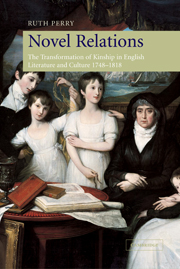Book contents
- Frontmatter
- Contents
- Acknowledgments
- Introduction
- 1 The great disinheritance
- 2 Fathers and daughters
- 3 Sister-right and the bonds of consanguinity
- 4 Brotherly love in life and literature
- 5 Privatized marriage and property relations
- 6 Sexualized marriage and property in the person
- 7 Farming fiction: Arthur Young and the problem of representation
- 8 The importance of aunts
- 9 Family feeling
- Bibliography
- Index
5 - Privatized marriage and property relations
Published online by Cambridge University Press: 22 September 2009
- Frontmatter
- Contents
- Acknowledgments
- Introduction
- 1 The great disinheritance
- 2 Fathers and daughters
- 3 Sister-right and the bonds of consanguinity
- 4 Brotherly love in life and literature
- 5 Privatized marriage and property relations
- 6 Sexualized marriage and property in the person
- 7 Farming fiction: Arthur Young and the problem of representation
- 8 The importance of aunts
- 9 Family feeling
- Bibliography
- Index
Summary
Marriage is a sort of Lottery; nor can all the Precautions in the World insure its certain Happiness.
Philogamus, The Present State of Matrimony: or, The Real Causes of Conjugal Infidelity and Unhappy Marriages (1739), p. 33.Jointures and Settlements … are not only the greatest Impediments towards entring into that State [marriage], but also the frequent Causes of Distrust and Animosity in it after it is consummated … I have [long] thought the Coldness of Wives to their Husbands, as well as Disrespect from Children to Parents, to arise from this one Sourse [sic]. This Trade for Minds and Bodies in the Lump, without Regard to either, but as they are accompanied with such Sums of Money, and such Parcels of Land, cannot but produce a Commerce between the Parties concerned suitable to the mean Motives upon which they at first came together.
The Tatler, September 12, 1710, from notes by Edward Wortley.Marriage was, for all ranks, the main means of transferring property, occupational status, personal contacts, money, tools, livestock, and women across generations and kin groups.
Margaret Hunt, The Middling Sort: Commerce, Gender, and the Family in England, 1680–1780, p. 151.From a 21st-century vantage point looking back three centuries, marriage would seem to be foundational to the meaning of family. But it is by no means clear that marriage was the most significant kin connection in earlier historical periods, even for women, when compared, for example, to daughterhood or sisterhood.
- Type
- Chapter
- Information
- Novel RelationsThe Transformation of Kinship in English Literature and Culture, 1748–1818, pp. 190 - 235Publisher: Cambridge University PressPrint publication year: 2004



